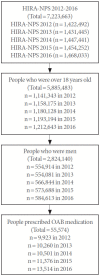Seasonal Variation of Drug Prescription Rate for Overactive Bladder in Men Based on National Health Insurance Claims Data, 2012-2016
- PMID: 33017898
- PMCID: PMC7538287
- DOI: 10.5213/inj.2040030.015
Seasonal Variation of Drug Prescription Rate for Overactive Bladder in Men Based on National Health Insurance Claims Data, 2012-2016
Abstract
Purpose: Overactive bladder (OAB) symptoms might be affected by weather, but only a few clinical studies have investigated this issue. We investigated seasonal variations in OAB-drug prescription rate (DPR) in men using nationwide claims data in Korea.
Methods: A total of 2,824,140 men aged over 18 years were included from the Health Insurance Review and Assessment service - National Patient Sample data between 2012 and 2016. Depending on the monthly average temperature, the seasons were divided into 3 groups, namely, hot (June, July, August, and September), intermediate (April, May, October, and November), and cold (January, February, March, and December) seasons. OAB-DPR was estimated using the claims data, and differences in its rate were examined among the 3 seasonal groups.
Results: The overall OAB-DPR was 1.97% (55,574 of 2,824,140). The OAB-DPR were 0.38%, 0.63%, 0.92%, 1.74%, 4.18%, 7.55%, and 9.69% in the age groups of under 30, 30s, 40s, 50s, 60s, 70s, and over 80 years, respectively; thus, the prescription rate increased with age (P<0.001), with a steeper increase after 60 years of age. OAB-DPR was 1.02% in the hot season, 1.19% in the intermediate season, and 1.27% in the cold season, with significant differences among the 3 seasonal groups (P<0.001). These seasonal variations persisted in the subgroup analysis in each age decade (P<0.001).
Conclusion: OAB-DPR varied with seasons and was significantly higher in the cold season than in the hot season, suggesting that cold weather may affect development and aggravation of OAB symptoms in men.
Keywords: Men; Seasons; Urinary bladder, Overactive.
Conflict of interest statement
Mr. Jae Hwan Kim and Ms. So Jeong Park are researchers of the Hanmi Pharmaceutical Co. Ltd., Seoul, Korea, but they made no influence on this work in relation with the company or its products. Other authors have no potential conflicts of interest to disclose.
Figures
Comment in
-
Commentary on "Seasonal Variation of Drug Prescription Rate for Overactive Bladder in Men Based on National Health Insurance Claims Data, 2012-2016".Int Neurourol J. 2021 Mar;25(1):93-94. doi: 10.5213/inj.2142014.007. Epub 2021 Mar 31. Int Neurourol J. 2021. PMID: 33819962 Free PMC article. No abstract available.
References
-
- Yoshimura K, Kamoto T, Tsukamoto T, Oshiro K, Kinukawa N, Ogawa O. Seasonal alterations in nocturia and other storage symptoms in three Japanese communities. Urology. 2007;69:864–70. - PubMed
LinkOut - more resources
Full Text Sources
Miscellaneous



